Low sensor settings
Device: MiniMed™ 670G insulin pump (MMT-1780K)
Low Settings allow you to be alerted if your sensor glucose (SG) is:
- Falling rapidly (Fall Alert)
- Approaching your low limit (Alert before low)
- Has reached your low limit (Alert on low)
- Has been suspended by using the SmartGuard™ feature (Suspend before low and Suspend on low)
Remember, the Sensor feature must be turned on before you can set any Low settings.
WARNING: Suspend before low and Suspend on low are not intended to be a treatment for low blood glucose. Having insulin suspended when glucose is low may not bring your blood glucose back to your target range for several hours. In that case, you run the risk of hypoglycemia. Always confirm your blood glucose readings with your BG meter and treat according to the recommendations of your healthcare professional.
Low limit
The first step is to set the low (Lo) limit. This can be set from 50 to 90 mg/dL. This is the value on which the other low settings are based. You can set up to eight low limits for different periods of the day or night.
Suspend before low
When Suspend before low is turned on, your pump will temporarily stop delivering insulin if your sensor glucose is at or within 70mg/dL above your low limit and is predicted to reach or fall below a level that is 20mg/dL above your low limit in 30 minutes. This keeps additional insulin from being delivered.
WARNING: Always confirm your sensor glucose readings with your BG meter and treat according to the recommendations of your healthcare professional. The Suspend before low feature uses the sensor glucose value, not your blood glucose value, to automatically suspend insulin delivery. Your pump automatically suspends insulin delivery when your sensor glucose is approaching the low limit. However your blood glucose reading may be higher or lower than the sensor glucose value. Assuming that your sensor glucose value is accurate may result in the delivery of too little or too much insulin, which can cause hyperglycemia or hypoglycemia.
Alert before low
When Alert before low is turned on, you will be notified when your sensor glucose is predicted to reach your low limit in 30 minutes. The Alert before low can make you aware of potential low glucose levels even before they occur.
Suspend on low
When Suspend on low is turned on, your pump will temporarily stop delivering insulin if your sensor glucose has reached or fallen below your low limit. This keeps additional insulin from being delivered.
WARNING: Do not use the Suspend on low feature to prevent or treat low glucose. Always confirm your sensor glucose reading using your BG meter and follow the instructions of your healthcare professional to treat low glucose. Using Suspend on low alone to prevent or treat low glucose may result in prolonged hypoglycemia.
WARNING: Do not use the Suspend on low feature until you have read the information in the user guide and received instructions from your healthcare professional. The Suspend on low feature causes the pump to temporarily suspend insulin delivery for a maximum of two hours. Under some conditions of use, the pump can suspend again, resulting in limited insulin delivery. Prolonged suspension can increase the risk of serious hyperglycemia, ketosis, and ketoacidosis.
Alert on low
When Alert on low is on, you will receive an alert any time your sensor glucose reading reaches or falls below your low limit. This allows you to test your BG and treat if necessary as instructed by your healthcare professional.
The Alert on low feature is automatically turned on when either the Suspend before low or the Suspend on low feature is turned on.
Snooze
Low Snooze is available once you have set your Low Settings. Low Snooze allows you to set the amount of time that you want to wait before you are reminded that an alert condition still exists. After a low alert is received and cleared, you will be alerted again only if the low alert condition still exists after the snooze time you have set.
Setting up your Low Settings for the first time:
1. Press Select, select Options, select SmartGuard, and select Low Setup.
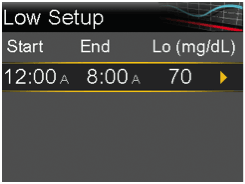
2. Select the time segment and the End time will flash. The Start time of the first time segment is always 12:00 A. You can set up to eight time segments, each with a different low limit. The segments must cover a 24-hour period. Set the end time for the first segment.
3. Select the Lo (mg/dL). You can enter a value from 50 to 90 mg/dL, in increments of 5 mg/dL. The value to defaults to 90 mg/dL. Press Select to set the value.
4. Press Select.
5. Select each feature you wish to turn on. If a feature is on, select it again to turn it back off. If you turn on Suspend before Low or Suspend on Low, Alert on Low will automatically turn on.
6. Once settings are selected, select Next. If you have not entered low settings for the full 24-hour time period you will be prompted to set the rest of the time segments.
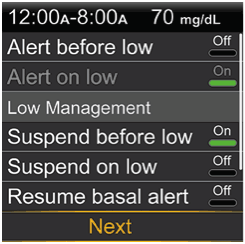
7. Select Done.
8. Review your settings for Low Setup and then select Save.
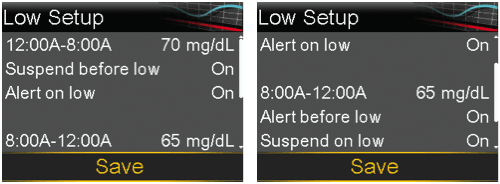
9. Select Snooze to adjust the amount of time before you will be alerted again. The default setting is 20 minutes (0:20 hr).
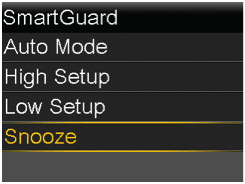
Edit your Low Settings:
1. Press Select, select Options, select SmartGuard, and then Low Setup.
2. Select Edit to change the settings for the current Low Setup.
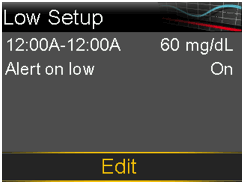
3. Select the time segment and the End time will flash. The Start time of the first time segment is always 12:00 A. You can set up to eight time segments, each with a different low limit. The segments must cover a 24-hour period. Set the end time for the selected segment.
4. Select the Lo (mg/dL). You can enter a value from 50 to 90 mg/dL, in increments of 5 mg/dL. The value to defaults to 90 mg/dL. Press Select to set the value.
5. Edit the alert settings as needed or scroll down and select Next.
6. When finished, select Done.
7. Review your settings and select Save.